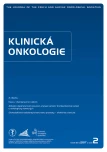Effect of Erlotinib in 2nd and 3rd Line Anticancer Treatment in Patients with Squamous Cell Lung Cancer – Case Series
Authors:
M. Šatánková 1; K. Brat 1; M. Tomíšková 1; B. Robešová 2; J. Skřičková 1
Authors‘ workplace:
Klinika nemocí plicních a tuberkulózy LF MU a FN Brno
1; Interní hematologická a onkologická klinika LF MU a FN Brno
2
Published in:
Klin Onkol 2017; 30(2): 131-135
Category:
Case Report
doi:
https://doi.org/10.14735/amko2017131
Overview
Background:
Squamous cell carcinoma of the lung (SCC) represents cca 30–40% of new cases of non-small cell lung cancer (NSCLC) in the Czech Republic. The tyrosine kinase inhibitor erlotinib is indicated as a 1st line treatment for patients with locally advanced and metastatic disease and activating mutations in endothelial growth factor receptor (EGFR), or as a 2nd or 3rd line treatment in EGFR-negative NSCLC patients after chemotherapeutic failure.
Observation:
We present three case reports of patients with SCC treated with erlotinib as a 2nd or 3rd line of treatment. All patients were verified by histological analysis of tumor samples. EGFR mutation status was negative in one patient, while the other samples were not suitable for genetic screening. Results: The therapeutic response to erlotinib lasted for 68, 40, and 13 months, resp. The patient with the longest therapeutic response (patient no. 1) is still continuing erlotinib treatment (as of December 2016). The overall survival of the two patients who died was 50 and 43 months, resp. One patient died of an unknown cause with no signs of progression of the disease on CT scans. The other patient died of terminal progression of the oncological disease. All three patients experienced major therapeutic benefit from erlotinib treatment as shown by the long periods of progression-free survival and prolonged overall survival.
Conclusion:
The three case reports demonstrate that erlotinib may be effective as a 2nd or 3rd line treatment in patients with SCC, especially in patients with limited alternative anticancer treatment options.
Key words:
non-small cell lung cancer – squamous cell carcinoma – erlotinib – treatment – tyrosine kinase inhibitor
The authors declare they have no potential conflicts of interest concerning drugs, products, or services used in the study.
The Editorial Board declares that the manuscript met the ICMJE recommendation for biomedical papers.
Submitted:
5. 8. 2016
Accepted:
14. 12. 2016
Sources
1. Dušek L, Májek O, Mužík J et al. Morfologie zhoubných nádorů průdušnice, průdušek a plic. In: Skřičková J, Kolek V (eds). Základy moderní pneumoonkologie. 1. vyd. Praha: Maxdorf 2012 : 22–24.
2. Skřičková J, Tomíšková M, Kaplanová J. Nemalobuněčný karcinom plic. Onkologická péče 2008; 12 (4): 5–9.
3. Hirsch FR, Varella-Garcia M, Bunn PA Jr et al. Epidermal growth factor receptor in non-small-cell lung carcinomas: correlation between gene copy number and protein expression and impact on prognosis. J Clin Oncol 2003; 21 (20): 3798–3807.
4. Robešová B. Molekulárně genetické vyšetření v diagnostice karcinomu plic. In: Skřičková J, Kolek V (eds). Základy moderní pneumoonkologie. 1. vyd. Praha: Maxdorf 2012 : 87–95.
5. Heist RS, Sequist LV, Engelman JA. Genetic changes in squamous cell lung cancer: a review. J Thorac Oncol 2012; 7 (5): 924–933. doi: 10.1097/JTO.0b013e31824cc334.
6. Skřičková J, Jakubíková L, Kadlec B. Biologická léčba nemalobuněčného karcinomu plic. In: Skřičková J, Kolek V (eds). Základy moderní pneumoonkologie. 1. vyd. Praha: Maxdorf 2012 : 235–254.
7. Ciuleanu T, Stelmakh L, Cicenas S et al. Efficacy and safety of erlotinib versus chemotherapy in second-line treatment of patients with advanced, non-small-cell lung cancer with poor prognosis (TITAN): a randomised multicentre, open-label, phase 3 study. Lancet Oncol 2012; 13 (3): 300–308. doi: 10.1016/S1470-2045 (11) 70 385-0.
8. Paik PK, Varghese AM, Sima CS et al. Response to erlotinib in patients with EGFR mutant advanced non-small cell lung cancers with a squamous or squamous-like component. Mol Cancer Ther 2012; 11 (11): 2535–2540. doi: 10.1158/1535-7163.MCT-12-0163.
9. Sette G, Salvati V, Mottolese M et al. Tyr1068-phosphorylated epidermal growth factor receptor (EGFR) predicts cancer stem cell targeting by erlotinib in preclinical models of wild-type EGFR lung cancer. Cell Death Dis 2015; 6 (8): e1850. doi: 10.1038/cddis.2015.217.
10. Non-Small Cell Lung Cancer Collaborative Group. Chemotherapy in non-small cell lung cancer: a meta-analysis using updated data on individual patients from 52 randomised clinical trials. BMJ 1995; 311 (7010): 899–909.
11. Favaretto AG, Pasello G, Magro C. Second and third line treatment in advanced non-small cell lung cancer. Discov Med 2009; 8 (43): 204–209.
12. Mountain CF. Revisions in the International System for Staging Lung Cancer. Chest 1997; 111 (6): 1710–1717.
13. Shepherd FA, Rodrigues Pereira J, Ciuleanu T et al. Erlotinib in previously treated non-small-cell lung cancer. N Engl J Med 2005; 353 (2): 123–132.
14. Soria JC, Felip E, Cobo M et al. Afatinib versus erlotinib as second-line treatment of patients with advanced squamous cell carcinoma of the lung (LUX-Lung 8): an open-label randomised controlled phase 3 trial. Lancet Oncol 2015; 16 (8): 897–907. doi: 10.1016/S1470-2045 (15) 00006-6.
Labels
Paediatric clinical oncology Surgery Clinical oncologyArticle was published in
Clinical Oncology

2017 Issue 2
- Metamizole in perioperative treatment in children under 14 years – results of a questionnaire survey from practice
- Metamizole vs. Tramadol in Postoperative Analgesia
- Safety and Tolerance of Metamizole in Postoperative Analgesia in Children
- Obstacle Called Vasospasm: Which Solution Is Most Effective in Microsurgery and How to Pharmacologically Assist It?
- Possibilities of Using Metamizole in the Treatment of Acute Primary Headaches
Most read in this issue
- Chemotherapy-related Cognitive Impairment in Patients with Hodgkin Lymphoma – Pathophysiology and Risk Factors
- Coffee in Cancer Chemoprevention
- Stereotactic Body Radiotherapy of Prostate Cancer – Effectiveness and Toxicity
- Trends in Prostate Cancer Epidemiology in Slovakia – an International Comparison
